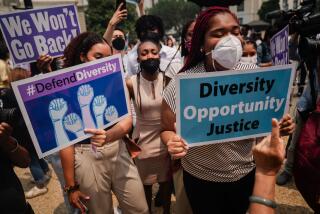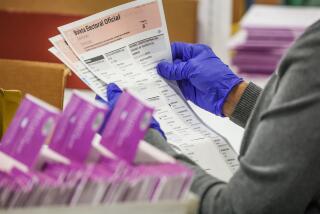For Census Bureau, Significance of Race Is More Than Skin-Deep
WASHINGTON â Filed in an office near the White House, handy for presidential perusal, is one manâs solution to the nagging need of the Worldâs Greatest Democracy to sort people by race.
John Beresford, a retiree in Alexandria, Va., proposed a numbered skin-color chart: Forget âblackâ or âwhiteâ; you could just pick the number nearest your skin tone.
When the Office of Management and Budget announced a few years ago that it was rethinking its racial and ethnic labels for Americans under a sweeping rule called Directive No. 15, Beresfordâs âSkin-Color Gradient Chartâ was one of the more dazzling suggestions from hundreds of citizens eager to help.
It also was among the easiest to discard, along with âAmeurofian,â concocted for people of American Native, European plus West African descent, and âWestern Europeanâ and âEastern Europeanâ to differentiate the great mass of whites.
Meanwhile, at the suburban headquarters of the U.S. Census Bureau in Suitland, Md., social scientists and volunteer advisors helping prepare questions for the next national nose count on April 1, 2000, wrestled with conundrums like this one: âAmerican Indianâ or âIndian (Amer.)â?
Their aim: to deter those with a heritage in the India of curry and Gandhi from checking that box as if they were Sioux or Cherokee.
For most of this decade--largely unseen, and on a democratic scale without precedent--the two agencies have enlisted help in and out of government to find up-to-date words for that awkward yet persistent question: What kind of American are you?
How the various kinds cluster across the land helps weigh the fairness of bank loans and school assignments, of employment and pay. The labels aid scientists tracking diseases that plague certain groups, and drug companies selling the cures. Theyâre used to ensure voting rights are upheld, and to attract federal, local and private aid for historic victims of bias.
George Washington was president barely a year when the first census was taken in August 1790. Its only purpose, then as now and fixed in the Constitution, was to apportion U.S. House seats.
But race mattered from the start. The first census counted âfree whiteâ males and females, any other free persons, and slaves.
In the 1840s, the government began asking outside experts for help devising questions about all sorts of things. The 1850 census was the first to ask census takers to record race, under a âcolorâ heading.
But it was the civil rights movement of the 1960s that paved the way for todayâs acute attention to what minorities and others have to say about how nonwhite, non-European people are counted in this country--not just for the census, but for a host of other government fact-gatherers.
Today there are racial minority advisors galore offering guidance, plus top researchers from government, universities and private enterprise, demographers and anthropologists, civil rights lawyers and marketing experts. The National Academy of Sciences was enlisted. The public trooped into hearings from Boston to Honolulu. Congress heard testimony.
John Beresford, a demographer whose career included two stints at the Census Bureau, died in 1995. But his skin-color chart survives amid the nearly 800 letters of advice for the government that fill four fat binders at the OMB.
Add the nameless good sports who submitted to test surveys, and participation soars upward of 250,000 Americans.
The OMB expects to issue its final decision on the basic racial and ethnic categories by mid-October, which should give the Census Bureau time to make any changes before its spring 1998 dress rehearsal.
Outside experts and advisors worked gratis, with only their modest accommodation and occasional travel costs paid. Many involved in the process were federal employees, so no extra labor costs were racked up. But officials estimate $5 million has been spent so far in this endeavor, most for research.
Government researchers, for example, spent months developing questionnaires, then trying them out on whites in West Virginia, Cajuns and Creoles in Louisiana, rural blacks in Mississippi, American Indians in Oklahoma, Hispanics in Texas and Asians on the West Coast.
âThis was just to work out question wording,â said Clyde Tucker, director of the Behavioral Science Research Center at the Bureau of Labor Statistics. With a sociologist at the Census Bureau, he co-chaired a research working group of 20 to 30 federal experts over the last few years.
The Census Bureau and the OMB have different missions. The bureau, as part of the Commerce Department, counts people. The OMB is the higher authority, dictating federal standards, including names for things and people.
The basic categories that OMB decrees are used by all federal agencies. But they pop up far beyond, from birth records to death certificates, at school enrollment time, and on job applications. And what the OMB decides, the Census Bureau must follow.
Still, the two agencies have collaborated in their mutual quest for precise categories. If people canât recognize themselves in the labels, the numbers will be off and the resulting picture of America all wrong.
âThis is a deeply personal issue,â said the OMBâs Sally Katzen, administrator of the Office of Information and Regulatory Affairs. âBut it also has to work.â
Many people wish the labels would go away. Many note that race is a social invention--like the old âone drop of bloodâ dictum that said a single African American ancestor turned an otherwise white family âblack.â
But that old standard still does not work in reverse for the millions of American blacks with white forebears. And to be dark-skinned in this country still can present obstacles, even danger. So the labels ensure a certain protection and aid; without attention to race, thereâs no way to check for inequities.
âThatâs where the paradox comes,â said Harvard professor Mary Waters, a demographer and sociologist. âBecause race is still such a reality in this society, we need to be vigilant against discrimination. Yet we perpetuate this by putting people in boxes.â
Waters had a hand in both the OMB and census research, a process she calls âreally messy.â
âAnd it strikes at the heart of our nationâs original sin,â she said. âBut in another sense . . . itâs just been so inclusive.â
Inclusive of people like Cyril Nishimoto, the grandson of Japanese immigrants who does Christian outreach in Glendale, Calif.
âTheyâre at least recognizing our voice is important to hear,â said Nishimoto, who serves on the Census Advisory Committee on the Asian and Pacific Islander Populations. âThough there are times we have to keep repeating things over and over,â he added, with a laugh.
Nishimoto is one of 36 advisors representing racial minorities and Hispanics. Thereâs also the Commerce secretaryâs 50-member 2000 Census Advisory Committee. That mega-panel takes up all census issues and, this summer, discussed race and ethnicity.
âIt was mind-boggling,â said the panelâs chairwoman, Mayor Ann Azari of Fort Collins, Colo.
âThere are people who feel left out,â she said of the race-ethnic stakes. âBut then how far do you go with it? . . . Some say, âLook, Iâm an American. I donât want to answer all of this.â â
In early July, after more than three years of consulting experts and citizens, trying out questions and holding meetings and more meetings, the OMBâs search neared its end.
A task force Katzen assembled from more than 30 federal agencies recommended slight changes in the current racial categories of white, black, Asian or Pacific Islander, American Indian or Alaskan Native, and the sole ethnic option, Hispanic.
âHispanicâ is not a race by the governmentâs definition, but a heritage of language and culture that can be any race--or blend of races. Itâs also the only ethnic category federal law requires the government to count.
Despite a rising clamor for a âmultiracialâ category, the task force rejected that term as confusing. Instead, it proposed allowing multiple choice for the first time, and also said the Hispanic origin question should precede the race question; the reverse confuses people. Everybody must indicate whether they are Hispanic or not, while checking all racial categories that apply.
The slight edits the task force recommended: Black should become Black or African American, with Haitian or Negro also allowed. Hispanic should be kept, but Latino or Spanish Origin permitted. American Indian should be retained, while Hawaiian should become Native Hawaiian.
A spur to reexamining the labels was the tiny but growing--and quite vocal--pocket of America that calls itself âmultiracialâ and doesnât like choosing sides by checking this box or that one.
Then there are the native Hawaiians, who want to be counted with American Indians and Alaskan Natives, not Asian and Pacific Islanders, as they are now. West Indians and others of Caribbean heritage object to being merely âblack.â Arab Americans, now lumped under âwhite,â would like their own category. And some people get flummoxed by the broad, and vague, âHispanic.â
In the 1990 census, 92% of Americans checked âwhiteâ or âblackâ to describe themselves.
But you donât need a census taker to see that recent decades of immigration from around the globe are altering the countryâs makeup as never before. More and more people want to identify their heritage. And more and more, states and local governments need to know about particular groups they serve.
One of the people most responsible for ensuring that the search for labels is democratic is Nampeo McKenney, who has overseen the development of the Census Bureauâs questions on race and ethnicity for more than 30 years.
She holds out hope that, someday, there will be less need for racial information.
âIt will be like questions we no longer ask,â says McKenney, âlike whether your house has electric lights.â
Many Americans are impatient for that day to arrive.
Among the hundreds of letters that poured into the governmentâs mailbox when the quest began was this heartfelt plea from Joanne Specht of San Jose, Calif.
âI do not encourage people to forget their heritage, but these demands to be called a Black-American or Asian-American, etc., are deunifying America,â she wrote. âWhy canât we all be called just American?â
Specht signed herself: âAmerican--freckled.â
More to Read
Get the L.A. Times Politics newsletter
Deeply reported insights into legislation, politics and policy from Sacramento, Washington and beyond. In your inbox three times per week.
You may occasionally receive promotional content from the Los Angeles Times.










